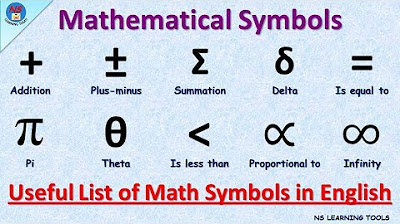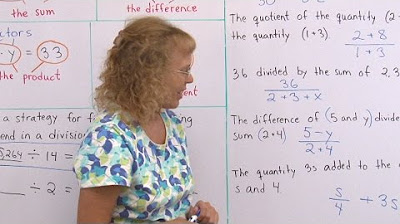Maths Symbols & Equations - English Vocabulary | Maths Vocabulary | Math or Maths | Basic Math
TLDRThe video script introduces viewers to the English vocabulary used in reading mathematical symbols, equations, and various mathematical concepts. It explains the difference between 'math' and 'maths,' and covers basic operations like addition, subtraction, multiplication, and division, as well as more complex ideas like fractions, decimals, roots, and exponents. The video also includes a quick test for viewers to apply their newfound knowledge, aiming to enhance their understanding and retention of mathematical terminology in English.
Takeaways
- 📘 The video introduces English vocabulary related to math symbols and equations.
- 📌 'Maths' and 'Math' are both correct, with 'Maths' used in British English and 'Math' in American English.
- ➕ In addition equations, the plus sign is used to combine numbers, and the result is called a 'sum'.
- 🔻 In subtraction equations, the minus sign is used to indicate the number being taken away, with the result known as the 'difference'.
- ✖️ Multiplication equations use the multiplication sign (or times sign), and the result is referred to as the 'product'.
- 🔢 Division equations involve the division sign, and the outcome is called a 'quotient'.
- 🔗 Brackets can be used in equations to indicate the order of operations.
- 📊 When reading equations, 'equals' is used to denote that two values are the same, while other symbols like 'not equal', 'greater than', 'less than', etc., indicate different relationships.
- 🥂 Fractions are read with the numerator as a cardinal number and the denominator as an ordinal number, with 's' added for plural in the denominator if necessary.
- 🔍 Decimals are read with the number before the decimal point followed by 'point' and the numbers after the decimal point, or as fractions if they represent tenths.
- 🌿 Square roots and other roots are read by stating the root type followed by the number under the radical sign, with exceptions for cube roots.
- ✅ The video concludes with a challenge for viewers to read a complex equation using the newly learned vocabulary.
Q & A
What is the main topic of the video?
-The main topic of the video is about teaching English vocabulary related to math symbols and equations.
What is the purpose of the quick test mentioned in the video?
-The quick test is designed to check the viewers' knowledge of reading mathematical symbols and equations in English.
What are the two forms of the word used for the subject of this video, and what are their regional differences?
-The two forms are 'maths' and 'math'. 'Maths' is used in British English, while 'math' is more common in American English.
How is the addition sign represented and read in an equation?
-The addition sign is represented by a plus sign. It is read as 'plus' in English. For example, in the equation '2 + 2 = 4', it is read as 'two plus two equals four'.
What do you call the result of a subtraction equation?
-The result of a subtraction equation is called a 'difference'.
How is the multiplication sign represented and read in an equation?
-The multiplication sign is represented by a times sign. It is read as 'times' in English. For example, in the equation '2 x 3 = 6', it is read as 'two times three equals six'.
What is the term used for the result of a division equation?
-The result of a division equation is called a 'quotient'.
How are brackets used in equations and how are they read?
-Brackets are used in equations to indicate that the numbers inside them should be considered as a group and performed first. They are read as 'in brackets'. For example, in the equation '1 + (2 x 3) = 9', it is read as 'one plus two in brackets times three equals nine'.
What are the different symbols that can be used instead of an equals sign in equations?
-Instead of an equals sign, you can use 'not equal to', 'greater than', 'smaller than', 'greater than or equal to', 'smaller than or equal to', and 'approximately equal to' symbols in equations.
How is a fraction read in English?
-A fraction is read by saying the numerator as a cardinal number and the denominator as an ordinal number. If the numerator is greater than 1, 's' is added to the ordinal number. For example, the fraction '1/5' is read as 'one-fifth'.
What is the correct way to read a decimal number?
-A decimal number is read by saying the number before the decimal point, followed by the word 'tenths' for the first digit after the decimal point, and then each subsequent digit. For example, '0.7' is read as 'zero point seven', and '0.727' is read as 'seven tenths, two hundred twenty-sevenths'.
How is a square root sign represented and read?
-A square root sign is represented by the radical sign. It is read as 'the square root of' followed by the number under the sign. For example, '√4' is read as 'the square root of four'.
What is an exponent and how is it read in an equation?
-An exponent is a small value that indicates how many times the base number should be multiplied by itself. It is read by saying the base number followed by 'squared' for an exponent of 2, 'cubed' for an exponent of 3, or 'to the power of' for any other exponent value. For example, '4^3' is read as 'four cubed'.
Outlines
📘 Introduction to Math Symbols and Equations
This paragraph introduces the video's focus on teaching mathematical symbols and equations in English. It emphasizes the importance of understanding these concepts for non-native speakers and provides a brief overview of what will be covered, including basic operations, the difference between 'math' and 'maths', and the reading of simple equations. The paragraph also mentions the intention of the video to serve as a language learning tool rather than a math lesson.
📙 Reading Variations and Advanced Concepts
The second paragraph delves into different symbols used in equations, such as equality, inequality, greater than, less than, and their respective readings in English. It also introduces more complex mathematical concepts like fractions, decimals, square roots, and exponents, explaining how each is read and used in equations. This section aims to enhance the viewer's ability to interpret and communicate various mathematical expressions in English.
📙 Practice and Conclusion
The final paragraph presents a practice equation to test the viewer's understanding of the concepts learned in the video. It encourages the viewer to attempt reading the complex equation and provides a 10-second challenge to do so. The paragraph concludes with a recap of the video's purpose and an invitation to explore more English vocabulary and grammar lessons through the 'Learn English with Tankmation' playlist.
Mindmap
Keywords
💡Math symbols
💡Equations
💡English vocabulary
💡Addition
💡Subtraction
💡Multiplication
💡Division
💡Brackets
💡Inequality
💡Fractions
💡Decimals
💡Square roots
💡Exponents
Highlights
Introduction to 'Learn English with Tankmation' focusing on math symbols and equations in English.
Explanation of the purpose: learning to read mathematical symbols and equations in English, not a math lesson.
Clarification on 'maths' vs 'math': 'maths' in British English, 'math' in American English.
Introduction to basic mathematical operations and their symbols: addition, subtraction, multiplication, and division.
Detailed explanation of reading addition equations in English, including variations.
Explanation of subtraction in English, with emphasis on the terminology 'difference'.
Discussion on multiplication, introducing the term 'product' for the result.
Introduction to division, explaining the term 'quotient' for the result.
Explanation of brackets in equations and their pronunciation in English.
Introduction to various inequality symbols and their readings in English.
Explanation of fractions in English, focusing on the numerator and denominator.
How to read decimals in English and the importance of the decimal point.
Introduction to square roots, including special terms like 'cube root'.
Explanation of exponents in English and how to read them.
Interactive knowledge test for viewers to apply what they've learned.
Conclusion and encouragement to revisit the lesson for better understanding.
Transcripts
Browse More Related Video

MATH & GEOMETRY Vocabulary and Terminology in English

List of Mathematical Symbols in English | Math Symbols Vocabulary | 65 Mathematics Symbols

Free English Class! Topic: Math! ➗➕➖ (Lesson Only)

Basic Math Review

Top 50 Mathematical Symbols In English and Greek

Terminology for the basic operations and writing algebraic expressions from words
5.0 / 5 (0 votes)
Thanks for rating: